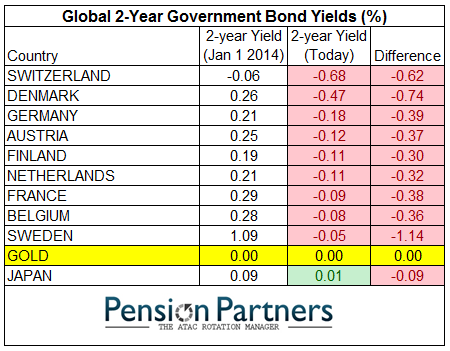Here is a run through of this weeks observations:
The Basic Model
One of my models is a simple allocation program between the total stock market, VTI, and long term government bonds, TLT. These two ETFs are a great pair to follow since they have almost the same average volatility. Thus, they can be compared based on pure relative strength with about equal expectations for each holdings appreciation or depreciation capability.
The current allocation for this program is Conservative (<40% stocks). This week saw a slight shift back towards bonds.
January was a weak month for US stocks. Traders are abuzz whether we will repeat a 2014 type performance or see more downside. With the number of defensive signs in the market and the technical differences between now and 2014, I am much more concerned about downside risk in US stocks this year. Buyers and sellers are much more in a dead heat this time around as longer term trends go flat.
Checking in on Five Horsemen of US Stock Risk for January
Mentioned a few weeks ago, I spoke on the ETFs I felt represented fear in the global markets, particularly as pertains to the US stock market. As you can see above, all five performed very well in January, reflecting widespread defensiveness to start the year. This is not conclusive evidence for a coming correction or bear market. It is merely an observation highlighting the heightened risk in US stocks currently.
Gold, a Zero Yield Investment?
I borrowed the chart below from Pension Partners to show something I am thinking about concerning the recent strength in gold. Gold is a traditionally inflationary asset, being a store of value when national currencies depreciate over time. However, gold has been strong to start the year in the face of both a strong dollar and a highly deflationary environment.
The strength could be caused by a shear fear trade as the other tail wind to inflation for gold is panic buying. However, many articles are coming out offering another fundamental reason why gold could find strength in an extreme deflationary environment. When bond yields go negative and are expected to continue to drop in the current environment gold can become competitive as an alternative investment to the safety of bonds. Yield is the classic advantage of investing in bonds over gold. Does gold catch a bid when this advantage is practically removed by negative interest rates?
Overall
Deflationary assets (bonds, dollar, inverse commodites, gold, defensive stock sectors) continue to lead and black clouds remain over the US stock market. I am still waiting for signs of a real fight in global stocks for the year. Will it come in February?
See you all next week!
See you all next week!




No comments:
Post a Comment